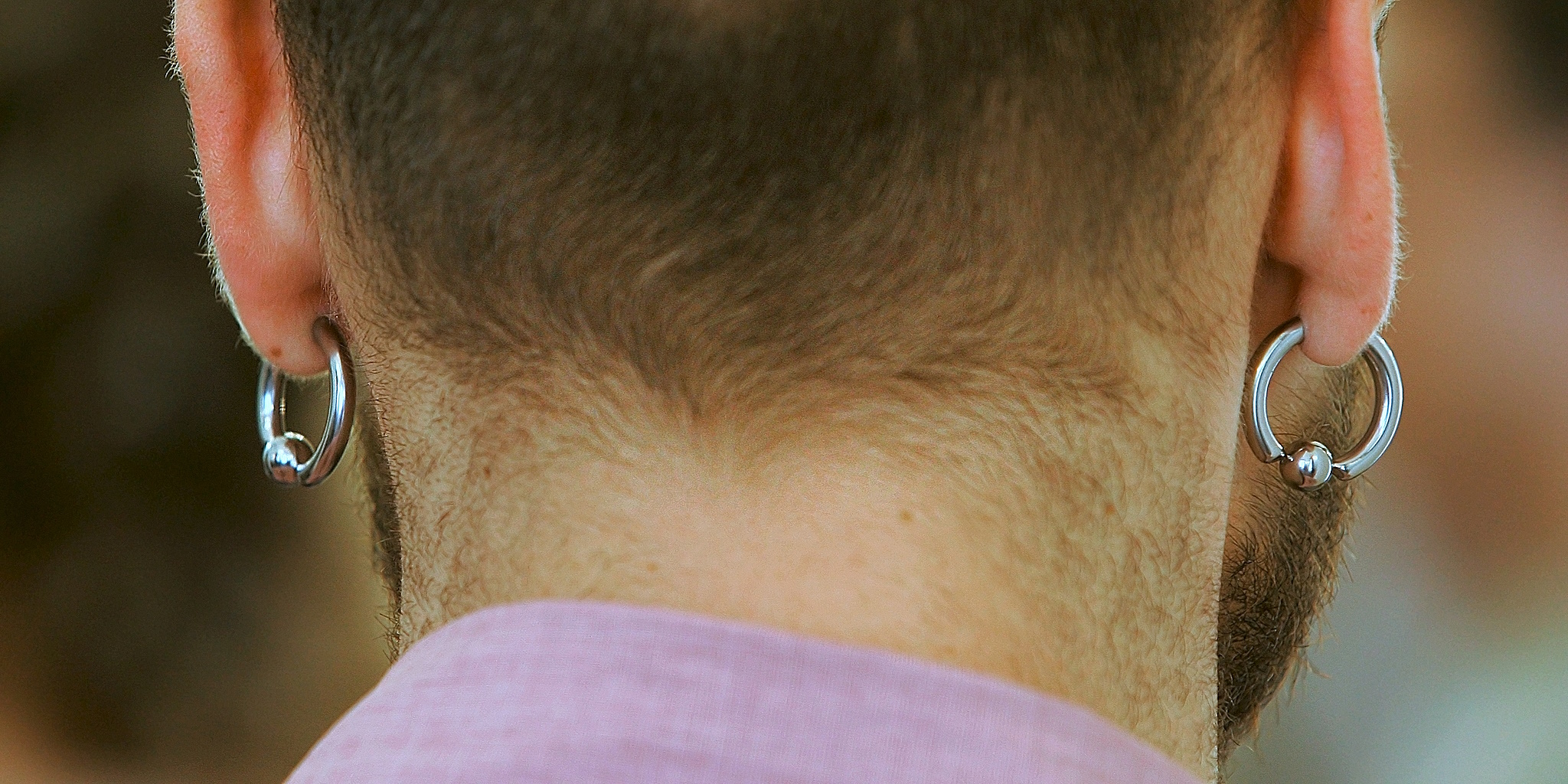
Earlobe Piercing Intricacies: The Full Story
Earlobe Piercing Article Quick Reference:
History | Myths | Complications | Pain | Cost | Procedure | Healing | Aftercare | Jewelry | Celebrities
The earlobe is the soft and fleshy lower part of the external ear that hangs down and is composed of connective tissue and skin. Earlobe piercings are by far the most common and popular type of ear piercing. They are also relatively painless and easy to take care of.
Although it is pretty obvious. Just in case, you will see a diagram below with the exact location of a traditional earlobe piercing.
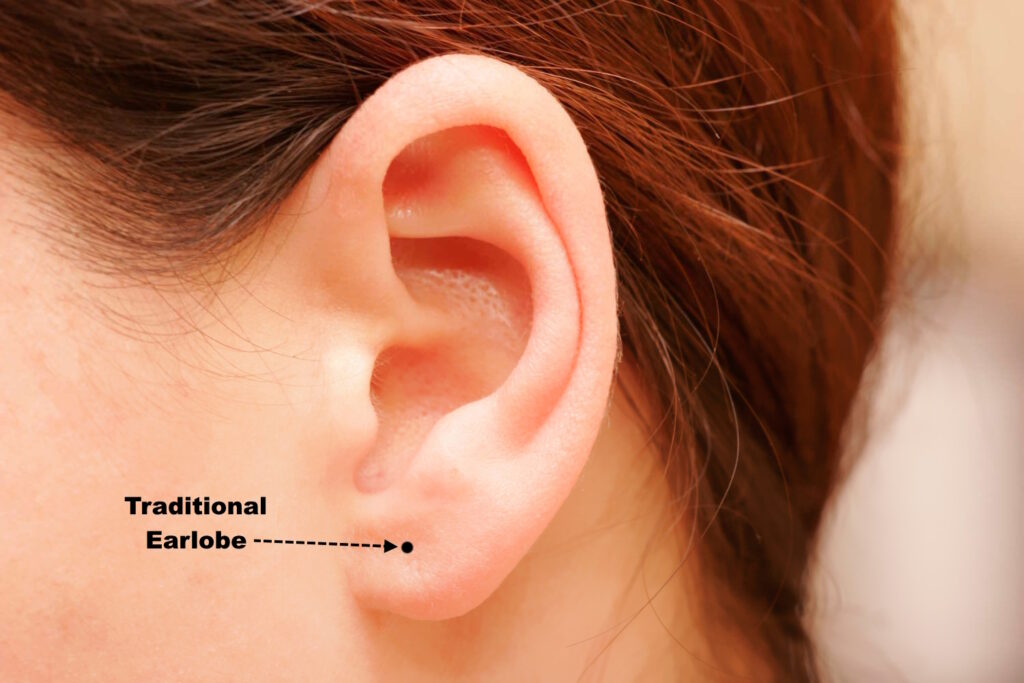
AN EARLOBE PIERCING HISTORY
Earlobe piercing has been a form of body modification for centuries. Different cultures have practiced it around the world. Historians believe that the practice dates back to ancient Egypt. Ear piercing there was a symbol of wealth and social status and was popular among men, women, and even children. Mummies, statues, and artwork from that era have shown this.
In other ancient cultures like Persia, Greece, and Rome, ear piercing was also a mark of social status. Rulers and prominent figures showed off elaborate ear jewelry. The historian Pliny the Elder wrote in his book Natural History about how Roman men wore a single earring. This is while women wore a pair of earrings.
During the Middle Ages and the Renaissance, ear piercing fell out of fashion due to religious and social reasons. The Catholic Church frowned upon body modification. However, pirates and sailors embraced ear piercing, and it became a symbol of their maritime profession. Some sailors believed that the piercing helped improve their eyesight and prevented seasickness.
In the 20th century, ear piercing came back into fashion in Europe. Also, in America after the First and Second World Wars. Soldiers and sailors returning back from the World Wars, brought back with them the fashionable souvenir of earrings. Apparently, they figured that guns, ammunition, and medals of valor were just too heavy. Therefore, a cute little earring was the next best thing to commemorate their travels. Soon, this stylish practice spread faster than a contagious virus at a crowded concert.
Finally, in modern times, earlobe piercing has become a popular and mainstream form of body modification. Earlobe piercings can be performed by trained professionals in specialized piercing or tattoo shops, using sterile techniques with needles.
MYTHS & MISCONCEPTIONS OF EARLOBE PIERCINGS
Here are some common myths and misconceptions about earlobe piercings and the actual facts behind them:
- Earlobe Piercings Should Be Done With A Piercing Gun: Guns are not sterile and should not be used for piercing. These terrible things canthey can cause unnecessary trauma. A piercing needle is a safer and more precise method that creates a cleaner hole, which promotes quicker healing.
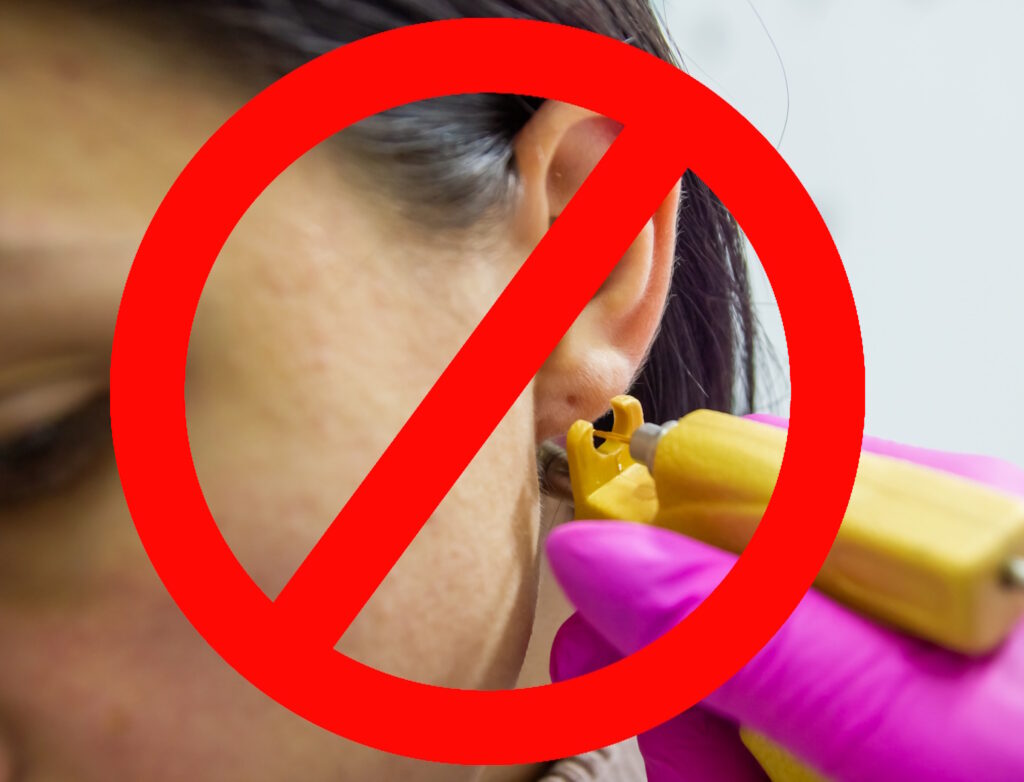
- Remove The Earlobe Piercing Jewelry At Night So The Hole Can “Breathe”: Piercings need constant attention and should not be left without jewelry. The piercing could close in as little as a few minutes. Do not remove jewelry for the first few weeks after getting your earlobe pierced.
- You Must Twist The Earring During The Healing Process: Twisting earrings can cause trauma. It is important to clean the piercing regularly with saline solution or a gentle soap.
- Piercing Your Earlobes Will Result In A Gaping Hole That Will Never Close: Well unless your earlobe is made of elastic, it’s highly unlikely. Ear piercings can close up quickly or take years to heal. However, there will be no gaping hole unless you of course have stretched them purposely.
WHO LIKES AN EARLOBE PIERCING MORE?
It is difficult to determine who has more earlobe piercings between men and women, or younger and older individuals. No concrete data is available that indicates specific numbers or ratios of earlobe piercings across different groups.
However, historically, women have been more inclined to have one or more earlobe piercings. This is because it has been a common form of adornment for many generations. In recent years, though, say the last 30 years, men have been increasingly getting earlobe piercings as well.
In terms of age, younger individuals are often more likely to have earlobe piercings compared to older ones. This is likely due to younger people being more open to new styles and trends. Also, because of the influence of pop culture. However, there are also many older individuals who have earlobe piercings, and some may even have multiple piercings in each earlobe. Ultimately, it is a matter of personal preference, and anyone can get earlobe piercings at any age.
Finally, in most places, there is a minimum age requirement for earlobe piercings. In most cases, individuals under the age of 18 will need parental consent. This is due to the fact that piercing involves a certain degree of risk, and the establishment wants to ensure that the client is mature enough to understand the procedure and the importance of proper aftercare.
THE POSSIBLE RISKS
While earlobe piercings are considered to be a relatively safe and common procedure, some possible risks and complications should still be taken into account:
- Infection: Earlobe piercings can become infected from bacteria from unsterilized equipment, dirty hands or unclean aftercare. An infected piercing may cause pain, swelling, redness, and discharge. If untreated, it can lead to more serious complications.
- Allergic Reactions: It is possible to have an allergic reaction to the metal in the earrings. Lower quality metals may cause itching, swelling, and redness.
- Keloids: Some people may be prone to keloids, which are thick, raised scars that develop around the piercing hole. Keloids can be uncomfortable and may not resolve on their own.
- Tearing: If earrings get snagged on something or are consistently tugged on, the piercing hole may become stretched or even tear.
- Nerve damage: The earlobe contains several sensory nerves that could be damaged during the piercing process, which may cause pain, numbness or a loss of sensation in the area.
WHAT COMPLICATIONS?
Before getting an earlobe piercing, it is also important to consider any medical conditions that you have that may increase your risk of complications during or after the procedure. Here are some medical conditions that you should take into account:
- Blood Disorders: You may be at risk of bleeding during the procedure and afterwards if you have a bleeding disorder or take medication to thin your blood.
- Diabetes: People with diabetes may have a slower healing process, which could increase the risk of infection or other complications.
- Skin Conditions: When getting piercing, skin conditions like eczema and psoriasis could get worse.
- Immune System Disorders: Individuals with immune system disorders such as HIV/AIDS may have a lower immune system function, making them more prone to infections.
- Autoimmune Disorders: Autoimmune disorders such as lupus or rheumatoid arthritis may put you at a higher risk for infection or slow healing after the piercing.
It is always important to discuss any medical conditions or concerns with your healthcare provider or piercer before getting a piercing to ensure you are making an informed decision and following best practices for your health.
WANT YOUR EARLOBE PIERCING REVERSED?
If you take an earlobe earring out, whether the hole will close permanently or not depends on various factors such as how long you have had the piercing, the size of the hole, and your body’s natural healing process. Another consideration is if you stretched the earlobe piercing.
In general, earlobe piercing holes might begin to close within a few hours to several days, especially if the piercing is new or recent. However, it could take a few weeks or months for the hole to heal completely or could even remain open permanently.
In most cases, when the hole does heal completely, it could leave a small mark or a scar behind. Also, if you tend to form keloids easily, you may experience more visible scarring.
In the case of stretched earlobe piercings, generally, a stretched earlobe piercing can fully close if the hole is no larger than 4 gauge (5mm) for at least a year or more. However, it is important to note that this is not a guarantee, and some individuals may find that their hole remains open even if they downsize to a smaller gauge.
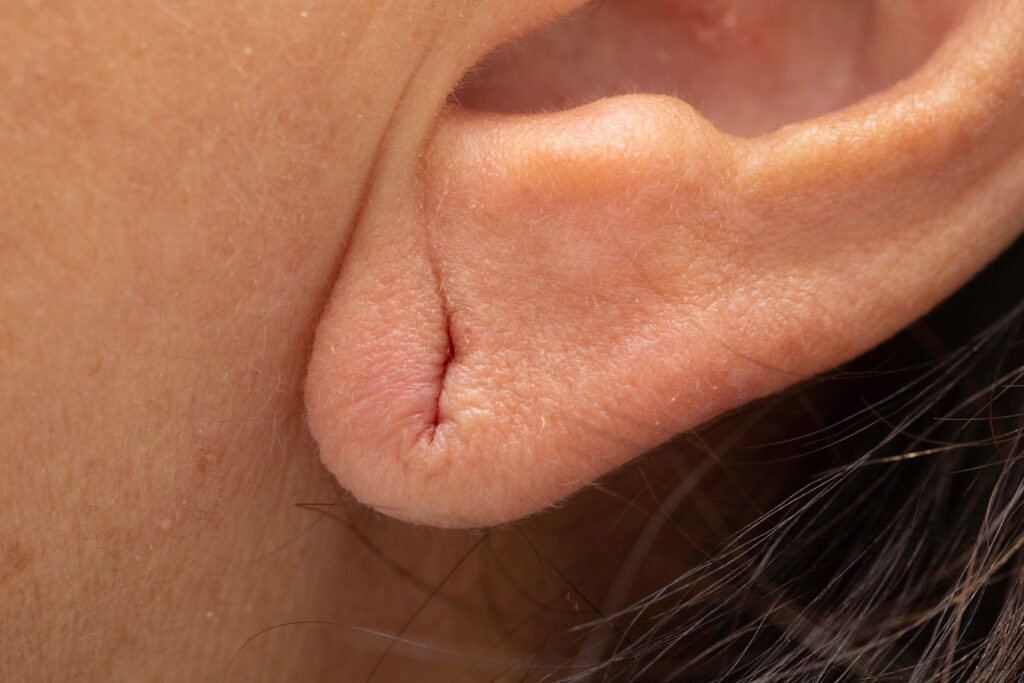
EARLOBE PIERCING PAIN AND PAIN MANAGEMENT
Ah, the infamous earlobe piercing pain. It’s like a quick pinch or pressure that leaves you wondering if it’s over yet. But hey, everyone has different pain thresholds, you might feel like you’re being attacked by a horde of angry mosquitoes or tickled by a feather. So, if it hurts, just count to three, and boom, before you can say “I think I need a drink”, it’s all over. The method used and the skill of the piercer can also play a part.
Pain and discomfort will grace you for the first few days. To manage this discomfort, you can follow these tips:
- Pain Medication: Take some pain relievers like acetaminophen or ibuprofen, but steer clear of aspirin due to the fact that it acts like a mild blood thinner.
- Cold Compress: Applying a cold compress, such as an ice pack or a bag of frozen peas wrapped in a towel, to the area can help reduce swelling and numb the earlobe.
- Rest: Get some well-earned rest as you are healing. Just remember not to sleep on the pierced side or risk waking up looking like you’ve lost a round against a boxer.”
It’s important to remember that any discomfort or pain you feel after getting an earlobe piercing is temporary and should subside over time. However, if you experience excessive pain, bleeding, or signs of infection, seek medical attention immediately.
WHAT WILL I PAY FOR AN EARLOBE PIERCING?
Curious about the cost of an earlobe piercing? You might be in for a surprise. Here’s the deal with the expected costs depending on where you’re located in the US:
- West Coast: In cities like Los Angeles, Seattle, and San Diego earlobe piercing rates generally range between $20 to $80, with San Diego typically being the least expensive.
- East Coast: In cities like New York City, Boston, and Miami earlobe piercing prices can be cheap to expensive, ranging from $20 to over $100 with NYC being the most expensive.
- Midwest: In cities like Chicago, Minneapolis, and Saint Louis prices are relatively affordable, ranging from $20 to $60.
- South: Cities in the south including Austin, Atlanta, and New Orleans charge anywhere from $20 to $60. The south is generally the part of the country with the cheapest earlobe piercing prices.
The prices listed above are about as accurate as a weatherman’s forecast. They could be higher, they could be lower, heck, they could even change depending on your piercer’s mood. So picking the right piercer is key. You want someone who’s got the skills. By skills, I mean the knowledge and experience to perform a safe and hygienic piercing. Oh, and make sure they’re using high-quality jewelry. Because, let’s face it, nobody wants to walk around with a piece of trash in their ear.
PIERCING PROCEDURE: STABBING AT THE LOBES
The standard size needle used for earlobe piercing is typically 20 gauge or 18 gauge. However, it’s always best to check with your piercer as different studios may use slightly different sizes.
Here is the standardized piercing procedure of the earlobe:
- Consultation: Your piercer will give you a brief rundown of what to expect and ensure that you’re comfortable with the process. They’ll also ask you for your preferences so they can help you pick out the perfect jewelry option.
- Preparation: Your piercer is about to get up close and personal with your earlobe. But no worries, they’re just preparing. They’ll clean the ear until it’s squeaky clean and mark the piercing spot with a dot.
- Anesthetic: Some piercers will numb the area beforehand. But if you are unlucky they won’t.
- Piercing: The moment you’ve all been waiting for – let’s get this piercing party started! Your piercer will whip out their sterile needle, ready to take on that lobe. It’s like a high stakes game of Operation, except this time, the buzzer noise is replaced with a sweet yelp from you. They’ll pass that needle through the marked spot and voila – a brand spanking new hole!
- Inserting Jewelry: The piercer will proceed to insert the preferred jewelry you picked out at the beginning of the procedure, into the freshly made hole. So it does not become dislodged the piercer will fasten it securely.
- Aftercare Instructions: Your piercer will provide you with all the do’s and don’ts along with necessary information regarding your aftercare routine to maintain your fresh piercing.
Remember, don’t get your panties in a twist if your piercer does things a bit differently. Just make sure they’ve got their act together when it comes to cleanliness and safety.
EARLOBE PIERCING HEALING TIME
Now, don’t go sticking all sorts of weird stuff in your ear holes and hope your ears will magically heal overnight. It doesn’t work that way, I’m afraid. Generally, an earlobe piercing takes about 6 to 8 weeks to heal, give or take a few days depending on how well you follow the aftercare instructions. So basically 1.5 to 2 months, which is a much shorter timeframe than many other types of piercings.
Remember though, everyone’s body is different and healing times can be too. So if it’s been exactly two months and you’re still a little crusty, don’t fret none. Just wait a few more days and I’m sure you’ll be good to go.
EARLOBE PIERCING AFTERCARE SUGGESTIONS
Now, let’s talk about aftercare. Nobody wants a crusty, infected earlobe, so it’s essential to follow the ideas below to get your earlobe piercing from “omg, ouch,” to “wow, look at me, I’m fabulous”.
- Clean The Area: Wash your hands first. Most had become covered in nasty germs and bacteria throughout the day. Then preferably use saline solution to rinse away any crusty bits that have formed around your jewelry. It’s good to use a Q-tip for this.
- Avoid Irritants: Steer clear of using chemicals such as hairspray, lotion and other skincare products including makeup near your new piercing.
- Avoid Headwear: Remember, hats that come down over your ears will irritate your new earlobe piercing. Do not use earphones while the earlobe is healing.
- Avoid Touching: Unless you’re an Italian grandma or a hugger, in which case, I’m sorry; however, try not to touch your earlobe piercing unnecessarily. Don’t play with it – it’ll slow down the healing process.
- Maintain A Healthy Diet: Eating a healthy diet is essential for healing an earlobe piercing. Make sure to include plenty of fresh fruits, veggies, and other nutritious foods in your meals to help speed up healing.
- Avoid Smoking And Alcohol: Smoking and drinking can decrease blood flow to your body parts and therefore slow the healing process and increase the risk of infection.
These suggestions won’t guarantee a flawless healing process but they will definitely help it along. If you have complications and you have followed these suggestions, it’s a good idea to contact your piercer or a healthcare professional to get additional assistance.
JOY TO THE JEWELRY CHANGE
First of all, you need to wait until your earlobe has lost all signs of still healing. This means no changing the jewelry before that 6 to 8 week mark, even if you think it’s ready for a new look.
- Be Gentle: Don’t go rummaging through your own ear hole like you’re searching for buried treasure! Be gentle when changing out the jewelry, and avoid any sudden movements or tugs.
- Avoid Tight Jewelry: Stay clear of tight and uncomfortable jewelry when you are ready for the long awaited change. In other words, don’t force any jewelry into your earlobe if it doesn’t easily fit.
- Clean The New Jewelry: Before changing out the jewelry, make sure to clean both the new jewelry and the piercing area. Use saline solution or unscented soap to do so.
- Monitor For Any Signs Of Infection: Be vigilant for any indications of infection or irritation after the exchange. Redness, swelling, or discharge are not allies of yours!
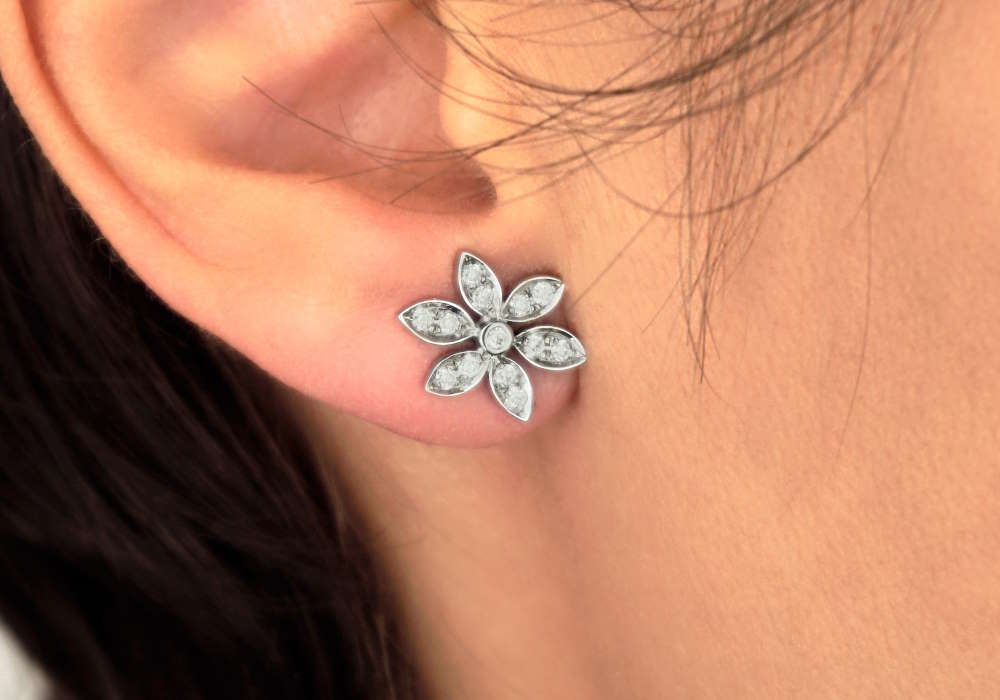
EARRING MATERIALS
Make sure to choose jewelry metals wisely so you don’t have any unforeseen problems with your earlobe piercing. The following materials are durable, corrosion-resistant, and biocompatible, making them a practical choice for everyday wear.
- Titanium: This metal is a great option for those with metal allergies as it is biocompatible and does not contain nickel. It is also lightweight and corrosion-resistant, making it an excellent choice for everyday wear.
- 14K Or 18K Gold: These metals are an excellent choice for those with sensitive skin. They are less likely to cause an allergic reaction compared to lower quality gold alloys. However, it’s essential to go for solid gold as gold-plated jewelry may contain nickel, which can cause an allergic reaction.
- Platinum: This metal is one of the purest and most hypoallergenic materials for earlobe piercings. It is also incredibly durable, corrosion-resistant, and tarnish-resistant, making it a practical choice for everyday wear.
- Surgical Steel: It is a popular option for earlobe piercing jewelry due to its durability, affordability, and hypoallergenic properties. It is highly resistant to corrosion and does not usually cause an allergic reaction.
- Niobium: This metal is also an excellent option for those with metal allergies. It is non-reactive with the body and does not contain nickel. It is available in a wide variety of colors and is a popular option for people looking for colored jewelry.
Don’t settle for shoddy earlobe jewelry made from subpar metals, as it could leave you with an angry lobe, a rashy fiasco, or even a nasty infection. Let’s be real, nobody wants to look like they got their ears pierced with a rusty stapler found in their dad’s tool shed!
OODLES OF EARLOBE EARRING DESIGNS
You can wear almost any type of body jewelry in earlobe piercings. See some below:
- Studs: This is a classic style of earlobe piercing jewelry that involves a single gemstone, a ball, or other decorative element attached to a short post.
- Hoops: Smooth circular earrings that adron earlobes. They come in different sizes and thicknesses.
- Captive Bead Rings: These are circular-shaped rings with a bead or ball that is held in place by the tension in the ring. Captive bead rings come in different sizes and materials.
- Circular Barbells: These are horseshoe-shaped metal pieces with a ball on each end. The balls screw on and off to insert and remove the jewelry in the piercing.
- Labrets: These are a type of jewelry that includes a flat disc on one end that sits on the back of the earlobe and a decorative attachment on the front end.
- Plugs: These are solid cylindrical pieces of jewelry that are inserted into stretched earlobe piercings. They come in various materials like metal, wood, acrylic, silicone, or glass, and range in size from tiny gauges to much larger ones.
- Flesh Tunnels: These are similar to plugs but are hollow in the middle and allow air and light to pass through them. Tunnels come in various materials and sizes and are also used in stretched earlobe piercings.
- Tapers: Tapers stretch earlobe piercings gradually by inserting increasingly thicker tapers into the piercing over time. Tapers should only be used with caution.
We all know how important it is to look drop-dead gorgeous, but let’s not forget about comfort! Make sure you choose a style that feels like a cozy hug in your precious earlobe piercing.
LARGER-THAN-LIFE EAR PIERCINGS: STRETCH FOR SUCCESS
People stretch their earlobe piercings for a variety of reasons, including personal style, cultural significance, or spiritual beliefs. It is important to note that stretching should be done slowly and safely to avoid damaging the tissue or causing infections.
To stretch your earlobes safely, start with a smaller gauge size and wait until the piercing is completely healed before moving up to the next size. Use lubricants like vitamin E oil during the stretching process, and stop stretching if you experience any major discomfort or bleeding.
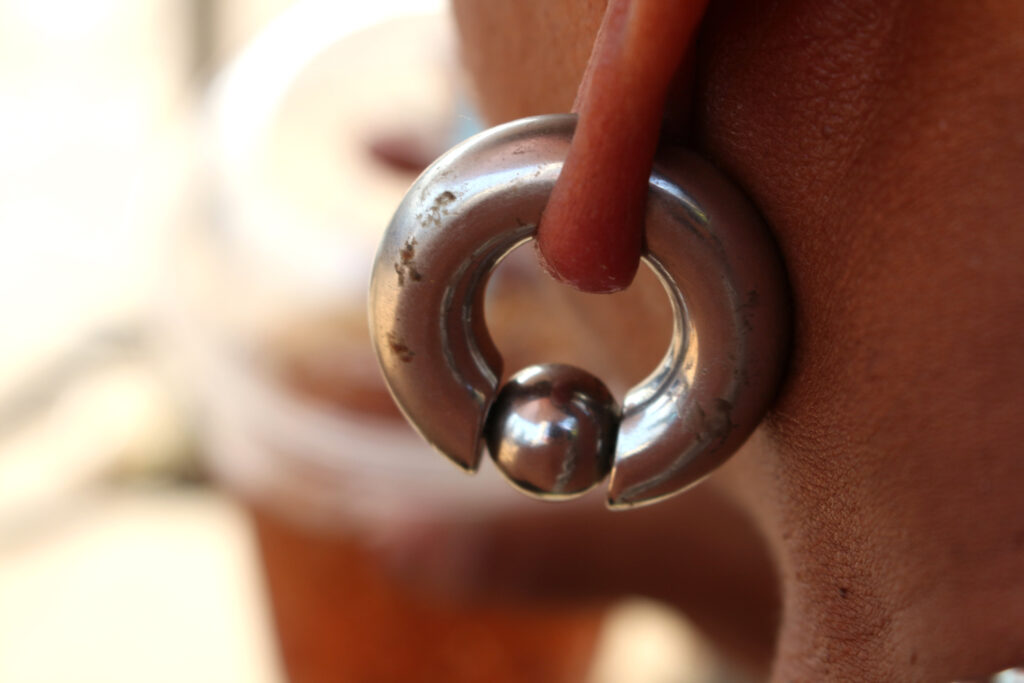
CELEBRITY EARLOBE PIERCINGS
Seriously, what kind of celebrity are you if you don’t rock earlobe piercings? These famous people got the bling!
- Rihanna: The singer and songwriter has multiple piercings on both ears, including the traditional earlobe piercings.
- Justin Bieber: The Canadian singer-songwriter is known for his multiple earlobe piercings, among other piercings on his face and body.
- Harry Styles: The English singer, songwriter, and actor has a couple of earlobe piercings in each ear.
- Beyoncé: The iconic singer has been seen wearing statement earrings in her earlobe piercings.
- Chris Hemsworth: The actor has been spotted with a single earlobe piercing on his left ear.
- Lady Gaga: The singer and actress has multiple piercings, including earlobe piercings that she often wears statement jewelry in.
Earlobe piercing is the secret ingredient to make you as stylish and fashionable as those celebs! But hey, let’s be real here, not everyone can rock a piercing like it’s nobody’s business. So, it’s important to consider if earlobe piercing is really your cup of tea before going all in.
ROCK YOUR LOBES: YES OR NO?
In conclusion, an earlobe piercing can be a beautiful and stylish addition to your overall style. It’s crucial to go to a licensed and experienced piercer, choose the proper jewelry that will fit you and your lifestyle, and take good care of your piercing during the healing process and beyond. With the right care, attention, and knowledge, an earlobe piercing can be a fun and exciting way to show off your personality and add a little extra flair to your look.
Need to find a piercer? Check out the Association of Professional Piercers.
Author: Scott S.
